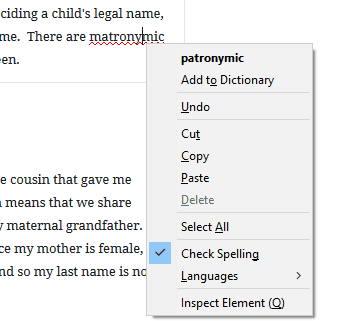Have you ever wondered why sometimes family trees seem to be more complete on male lines? Have you struggled with finding information about your female ancestors? Do you focus on certain lines of your family tree over others? Have you noticed sexism in genealogy research?

Before I continue, I would like to stress that I am not implying that individual genealogists tend to be sexist. Instead, I'm making observations based on my own experience in genealogy research, and I believe that having this discussion can help us build better family trees going forward.
Our female ancestors are just as important as our male ancestors
I was given the last name "Brons" when I was born. It was my dad's name, and he inherited it from his direct male line going back to the Netherlands. My dad knew a little bit about his Dutch ancestors, and so my sisters and I basically described ourselves as "Dutch" whenever anyone asked where our family was from.
My dad's paternal uncle did some wonderful genealogy research and presented several members of the family with a nicely-bound book filled with pedigrees. The "Brons" line is very thorough, going hundreds of years in time to the 1600s.
The female lines? They are not nearly as complete.
I'm sure my great-uncle didn't mean for his family tree research to leave out information about our female ancestors. Historical and societal conditions conspired against him, making it more difficult for him to learn information about our maternal relatives.
Surnames are sexist
Most countries used a patronymic system for deciding a child's legal name, meaning children are given their father's surname. There are matronymic naming systems that use the mother's surname, but they are few and far between.

The truth is that no matter which system is used, half of the child's ancestry isn't accounted for in the surname.
A few years ago, I had an interaction with a male cousin that gave me pause. His father is my mother's brother, which means that we share grandparents, and he carries the surname of my maternal grandfather.
Let's just say that his surname is "Mitchell". Since my mother is female, she took the surname of her husband (my father), and so my last name is not Mitchell.
I wanted to share a story about our Mitchell ancestors with him, and he seemed confused as to why I was researching the Mitchell ancestors. "You aren't a Mitchell," he said to me. While my last name isn't Mitchell, I am just as related to our Mitchell ancestors as he is.
This led me to give a lot of thought to the way surnames are used and passed down. While "Mitchell" is listed on my birth certificate as my mother's name, it's not my last name, and I won't pass it down to my children or grandchildren.
I'm not suggesting that we change the way surnames are used, and I don't have any better ideas for how we could give more "weight" to the mother's name and the implications that come along with names. Even so, I do believe it is fair to acknowledge that the way things are done does make harder to learn our our maternal ancestors and easier to forget them.
Yes, researching maternal ancestors is harder
Just last night, I was researching one my 6th great-grandfathers, Joseph Cross of Vermont. Checking through Ancestry records, I spotted a hint for a potential birth record. The birth record lists the father's complete name, but prints only a first name for the mother.
Her name is Mary.
But Mary who?
If you have done any significant amount of family tree research, you will probably noticed that it is more difficult, in general, to locate information about your female ancestors versus. Before everyone gets up in arms, I would like to note that I am not saying it is easy to research male ancestors, only that it is often harder to research females.
Over the course of history, males have dominated the legal and social order. Males have decided how records are kept, and which records are important to keep.
Women were often viewed as property or second-class citizens, and generally did not (and in some places, still do not) count as a completely independent person from their fathers or husbands.
Historical records reflect these values.
For example, if you have looked closely at US Federal Census records, you might notice that before the 1850 census, only the male head of household is listed by name on the census form. The women and children are only counted as numbers. You will not be able to learn much definitive information about your female ancestors from older census records.
History is sexist, too!
Have you ever heard the saying that history is told by the victors? Well, it's true.
It's also true that the victors (i.e. the tellers of history) have historically been high up in the patriarchal power structure (i.e. male). We could debate all day long about whether our current system is patriarchal, but historically, it was definitely the case.
Sure, we have a handful of stories about powerful women achieving something great in history, but these stories are only told because their actions propelled the priorities of the patriarchy forward.
Remember my example about Joseph Cross's birth record? Unless Mary came from a family with a much greater social standing than that of her husband, her surname was generally unimportant.
This means that it is more difficult for family tree researchers to learn about the more nuanced (read: deemed unimportant by historical society) aspects of their family's history. We have to do even more digging to learn what our female ancestor's lives might have been like, and to get clues as to who they were as individuals.
How to make sure your family tree doesn't suffer from past sexism
There is nothing we can do to change history, true. But it turns out there is something that you can do to make sure that your female ancestors are recorded in history.
Your family tree is a historical document that you are creating. You are the author of your family's history. What is the story that you want to tell?
I think about one of my great-great grandmothers. She was born in Poland and has a tricky last name.
I've only seen her name spelled twice, once on a baptismal record, and another on a delayed birth record that her son filed when he was in his 40's. Both times, it is spelled differently, and incorrectly.
Any other time I have seen my great-great grandmother mentioned in writing, she is referred to using her husband's last name.
Her husband, my great-great grandfather, is well-documented by a relatively modern paper-trail. My great-great grandmother, however, who died before she could meet her grandchildren, remains a mystery to me.
She is obscured by time and circumstance.
To ensure that my great-great grandmother's story is told through my family tree, I make sure to spend a lot of time researching her. I want to learn everything that I can about where she lived, what life was like for women where she lived during her life.
Each detail gives a clue that might help me piece together her past.
To summarize, I am suggesting that you decide that story that you would like to tell. And don't forget the women!

Conclusion
I hope that you found this post interesting. I'd love to hear your (politely phrased) perspective on this topic, especially if you have encountered sexism in your own genealogy research.
Please join us in the discussion below.
Thanks for being here today 🙂


Allison Morrill
Saturday 18th of May 2024
Thank you for bringing these issues forward. I am writing a genealogy of my ancestors going back 5 generations from each of my grandparents. I am trying to comply with traditional genealogical notation - but only to a point, as I am also trying to write it using gender-neutral, or gender-egalitarian notation. While I relish this challenge, I also worry that, in doing so, I'll run afoul of criteria for publishing. If necessary, I will self-publish. I would love to share observations with anyone else who is trying to do similar non-conventional genealogical writing. Best regards, Allison
Kristin
Thursday 18th of January 2024
Thank you for this honest and essential article about the challenges of documenting our foremothers! Although it pains me to see you twist yourself up in preemptive apologies to stave off the angry mobs offended by naming acts of the patriarchy, it is time this issue is amplified. In my genealogy work, I've created custom templates that elevate the details of the women who were previously written out of the story. The best tool I've found is researching hyper-local historical events and learning about cultural traditions that persevered as our ancestors colonized America. Understanding these forces can illuminate women who we otherwise wouldn't know much about. Keep up the good work, and never let them quiet your voice!
Reginald Arthur
Sunday 12th of November 2023
Very good explanation about sexism ! Later , Reg 👍
Sarah
Wednesday 22nd of March 2023
Totally agree. I thought this while compiling a family tree. Before starting I had no idea that family trees omitted so many females.Why are we following a certain surname and not who we are related to male and female? I’m going my own way on this and including everyone. It makes for a larger family tree but as I’m doing this on an excel spreadsheet I have all the space I need.
Doris Austin
Tuesday 12th of May 2020
Old obituaries are frustrating - for example: Mrs. David Jacobs passed away and is survived by her daughter, Mrs. Ralph Carpenter. What??? Neither woman has an identity! What if the men had been married more than once. Which wife is the one in the obituary.
Mercedes
Wednesday 13th of May 2020
Hi Doris! I agree, it's so frustrating. Thank you for reading, Mercedes